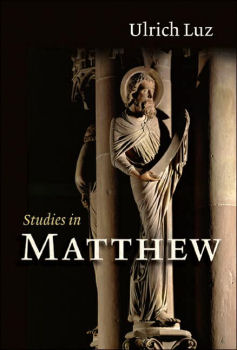
|
Posted December 1, 2005
Book: Studies in Matthew Author: Ulrich Luz Wm. B. Eerdmans Publishing Co., Cambridge, U.K., 2005, pp. 285 An Excerpt from the Jacket:
Luz’s groundbreaking work ranges widely over the critical issues of Matthean studies, including the narrative structure and sources of the Gospel and its presentation of such themes as christology, discipleship, miracles, and Israel. Several chapters also outline and demonstrate the hermeneutical methods underlying Luz’s acclaimed commentary on Matthew, for which this book can serve as a companion. Luz is particularly conscious of the Gospel’ s reception history, a history of interpretation connecting us with the past that determines so many of our questions, categories, and values. Studies in Matthew thus constitutes a noteworthy contribution to biblical hermeneutics as well as to exegesis. An Excerpt from the Book: The Gospel of Matthew is a book intended to be read as a whole and not in parts or pericopes. It is intended to be read not just once but several times. Matthew’s Gospel is not a lectionary or a collection of material for instruction. It is written to be read aloud. It makes considerable demands on its readers. My premise is that the evangelist expresses himself in a manner that is intelligible to his imagined readership. My argument is based on a large number of formal and compositional elements observable in the Gospel. For example, Matthew makes use of keywords. In the Sermon on the Mount he repeats the word righteousness five times and the word father fifteen times. Taken together, these two keywords express the theology of the Sermon on the Mount. In Matt 8-9 the keyword [to follow] occurs nine times, and in chapters 11-12 there are eleven instances of the keywords [judgement]. In each case the keywords are central to the them of the passage. Only a reader following the text in full could recognize this. The same is true of repetitions. Matthew has not only adopted doublets from his sources, such as the two feedings of the crowds or the two demands for signs. He himself has created repetitions, such as the passage on the tree and its fruit (7:15-20; 12:33-35), the healing of two blind people, or the summary of Jesus’ healing and preaching activity among the people of Israel. Since he creates such doublets through his own redaction, we are ill advised to reproach Matthew with clumsiness when he adopts doublets from his sources. He repeats what is important to him, and once again this can be recognized only by reading the whole text continuously. . . . then there are signals in Matthew’s Gospel, distinctive features in the narrative which point beyond their immediate context and whose meaning is not really apparent to readers. The prologue is full of such signals, “son of Abraham” “Galilee of the Gentiles”, the mountain on which Jesus refuses the devil’s offer of the kingdoms of the world, or the bizarre episode of 2:3-4 in which all Jerusalem, all the chief priests and scribes of the people, and the hated half-Jewish Herod are united in fright when three Gentiles ask where the Messiah has been born: all these are “signals” pointing to what Matthew will later narrate concerning Jesus’ rejection by all Jerusalem and the coming mission to the Gentiles. Only readers familiar with the whole Gospel will recognize the signals. Table of Contents: Matthew’s Story Matthew and his tradition Christology Ecclesiology Ethics Miracles Matthew and Israel Hermeneutics with Matthew in mind |
|
